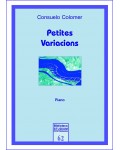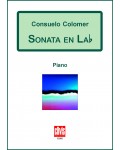
No products
Prices are tax included
Product successfully added to your shopping cart
There are 0 items in your cart. There is 1 item in your cart.
- English
- Castellano
- Català
Dansa - Tres peces breus
DE549
Dansa is an extraordinarily brilliant piece, with admirable piano writing. The Tres Peces Breus pieces were composed in 1932, and their harmonic language is close to the vaporous and refined sonorities of Frederic Mompou’s music. The three pieces share an interesting mirror structure (ABCBA), a variant on the traditional ternary Lied.
| Period | 20th c. |
| Subheading / Parts | Tres peces breus: Cançó de bressol - Paisatge - Pastor enamorat |
| Instruments | piano |
| Pages | 24 |
| Time | 15 min |
| Contents | score |
| ISMN | 979-0-3502-0629-0 |
| Price of print edition | 15,60€ |
| Others | Jordi Masó (revision) |
| Edition | Digital |
Dansa (Dance) and Tres Peces Breus (Three Short Pieces) are Joaquim Serra’s only contribution to the solo piano repertoire. Dansa, which was written in December 1931, is an extraordinarily brilliant piece, with admirable piano writing. Its constantly irregular rhythm (resulting from alternating 3/4 with 2/4 rhythms), the frequent use of syncopated accents, and a certain degree of severity in the first part of the piece, bring it closer to Igor Stravinsky’s universe, even though the central section evokes outflows more characteristic of romantic piano – already well exploited by Serra in his 1926 work Trio per a violí, violoncel i piano (Trio for Violin, Cello and Piano). The original manuscript for Dansa includes annotations for a possible choreography.
The Tres Peces Breus pieces were composed a year later, in 1932, and their harmonic language is close to the vaporous and refined sonorities of Frederic Mompou’s music. The three pieces share an interesting mirror structure (ABCBA), a variant on the traditional ternary Lied. The central section of the delicious Cançó de bressol (Lullaby) which opens the three-part piece includes a passage to be played a piacere, by way of cadenza over a seventh chord, producing a magical rhythmic suspension and stopping the distinctive rocking which permeates the piece. Paisatge (Landscape) carries on Cançó de bressol’s quiet and idyllic nature, while Pastor enamorat (Shepherd in Love) is a toccata bringing together elements of clearly popular origin both in its bucolic start – where a tune imitates the sound of a flute – and in the more excited and technically difficult central section.
Jordi Masó




































![Tema amb [4] variacions](https://www.clivis.cat/1964-home_default/tema-amb-variacions.jpg)
![Tema amb [10] variacions](https://www.clivis.cat/1709-home_default/tema-amb-variacions.jpg)

